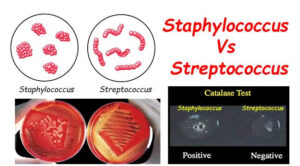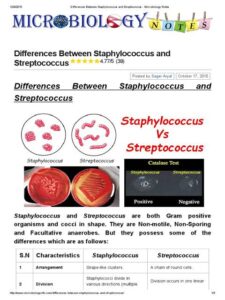Back to: MICROBIOLOGY 300 LEVEL
Welcome to class!
It’s always a joy to have you back, and I’m proud of how far you’ve come. Today, we’re getting to know two important bacteria that cause many common infections—Staphylococcus aureus and Streptococcus pyogenes. These names might sound big, but by the end of this lesson, you’ll understand what they are, how they behave, and why they matter—especially in Nigeria, where these bacteria are often involved in everyday infections.
Staphylococcus Aureus, Streptococcus Pyogenes
Introduction to the Culprits
Let’s imagine two neighbours—both troublesome in different ways. One sneaks into your house and causes trouble (like boils and food poisoning), while the other attacks out in the open with sore throats and skin infections. These two neighbours are Staphylococcus aureus and Streptococcus pyogenes.

They are both Gram-positive cocci (round-shaped bacteria), but they behave quite differently.
Staphylococcus aureus
Appearance & Structure:
Appears in clusters like grapes under the microscope. Gram-positive and catalase-positive.
It is also coagulase-positive, which helps it form clots and hide from the immune system.
Where it’s found:
Commonly found on the skin, in the nose, and other body surfaces. It can be part of the normal flora in healthy people but turns harmful under the right conditions (cuts, weak immunity, etc).
Diseases caused:
Skin infections: boils, abscesses, impetigo
Food poisoning: from contaminated food due to toxin production
Scalded skin syndrome in infants
Toxic shock syndrome
Wound infections and post-surgical complications
Pneumonia and endocarditis in severe cases
Virulence factors:
Produces toxins (like enterotoxins and TSST-1), enzymes (coagulase, hyaluronidase), and protein A (helps it avoid immune detection).
Resistance issues:
Some strains, like MRSA (Methicillin-Resistant Staphylococcus aureus), are resistant to many antibiotics and pose a big challenge in hospitals.
Streptococcus pyogenes
Appearance & Structure:
Forms chains under the microscope. Gram-positive and catalase-negative. It is classified as Group A Streptococcus (GAS).
It’s beta-haemolytic—completely breaks down red blood cells on blood agar, which helps identify it in the lab.
Where it’s found:
Lives in the throat and on the skin, especially in children. It spreads easily through sneezing, coughing, or contact with infected wounds.
Diseases caused:
Strep throat (sore throat with fever and swollen tonsils)

Scarlet fever (fever with a red rash)
Skin infections like impetigo and cellulitis
Rheumatic fever and glomerulonephritis as complications
Necrotising fasciitis (a life-threatening condition that destroys tissue quickly)
Virulence factors:
Produces M protein (helps avoid immune destruction), streptolysins, hyaluronidase, and pyrogenic exotoxins.
Example in Daily Life
Imagine a child in a crowded school in Lagos. He scratches his skin during play, and Staph. aureus on the skin enters through the cut, causing boils. Another child comes to school sneezing and coughing. That’s how Strep. pyogenes spreads—causing sore throat or impetigo, especially in places with poor hygiene.
Summary
- Staphylococcus aureus and Streptococcus pyogenes are Gram-positive cocci that cause many common infections.
- Staph is found in clusters, catalase-positive, and known for skin and toxin-related illnesses.
- Strep forms chains, is catalase-negative, and causes throat and skin infections, with dangerous complications.
- Proper hygiene, early diagnosis, and appropriate antibiotics are key to managing both.
Evaluation
- What is the main structural difference between Staph. aureus and Strep. pyogenes?
- Name two infections caused by each bacterium.
- Why is MRSA a concern in hospitals?
These are the kind of microbes you’ll meet both in the lab and in real life. Knowing how they work helps you protect lives and promote better health in your community. Keep going strong—Afrilearn is here to walk with you every step of the way. See you in the next class!
